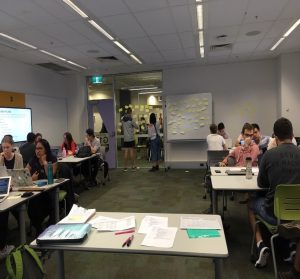 Students make wonderful teachers.
Students make wonderful teachers.
Some of the ‘aha’ moments I value most have come from debriefing de-identified mediation challenges (particularly the most painful ones) with my class – listening and learning as they unpick my stories of ‘successes’ and ‘failures’. It is a gift I look forward to receiving with each new group of students. My current crop has not disappointed.
Let me explain.
Early intervention occupies a big slice of my practice, however lately a small handful of fully formed, dug in conflicts have been occupying my time. They have particular characteristics. The parties have been in business together for at least a decade.
The businesses are complex with inter-related entities. The parties have ‘skin in the game’ via equity and personal guarantees. One of these conflicts is complicated by family relationships. These businesses will likely survive the virus threatening the world but they will be buffeted and they are facing huge risks. The perception in the marketplace of internal conflict between stakeholders would be very damaging. To date confidentiality has been tightly controlled.
It has felt strange to be referred several conflicts that are so similar because I am accustomed to wildly different cases. However I saw this as an opportunity to refresh my skills in the enduring conflict space. Because these conflicts are longstanding – bubbling under the surface for a considerable time. It appeared to me that the conflicts sprang from disagreements about business practices, risk management, leadership and accountability for behaviour. There will not be litigation – so far there does not appear to be a cause of action and the parties have not been accompanied by legal representation.
The mediation process
The 2 conflicts requiring most of my attention proceeded in a similar way. We agreed early that the process would not be rushed and we would begin with a series of exploratory meetings to map the conflict and the stakeholders. Early sessions with individual stakeholders went well and were productive.
My strategy
The success of the early sessions reassured me that my strategy was helping the mediation to progress at an appropriate pace. Next I organised what was to be a succession of group meetings. One of the learnings from my conflict coaching training (which filled a significant gap in the mediation training I undertook) was about the practice of ‘holding the space’ – allowing and accepting what is being presented by simply being present – without judgement and without requiring acknowledgement. It takes a lot of practice and I think perhaps I was feeling a bit smug about my familiarity with this tool.
As it turned out, I was not as clever as I thought. The parties turned up to several of the meetings. I offered the opportunity of holding the space. There was some minor ‘tip-toeing’ into the conflict and then at least one or all the parties moved into ‘chit chat’ mode, discussing the market, competitors and other things unrelated to the conflict. Then they left.
I was feeling puzzled and a significant lack of confidence.
Students to the rescue
As good fortune would have it, my undergraduate dispute resolution class was due to meet. We were in the middle of a teaching process I have developed called ‘A Day in the Life of a Mediation’. It involves deconstructing a mediation to extract learning about skills and process. It seemed sensible to take one of the challenging mediations (de-identified) as the case study for the day.
Their deconstruction was thorough, not especially good for my ego and one of the best lessons I have ever had. Following some very convincing role-playing and lots of sticky notes on the virtual whiteboard they delivered the following diagnostic:
- The intake process appeared well structured and effective
- The staggered meetings provided good risk minimisation
- Holding the space had taken a lot of my attention and distracted me from a more objective diagnosis of what was happening and why
- The best resource for a diagnosis and an amended process plan was right under my nose
The outcome – a work in progress
They referred me to the bibliography in the course outline. They reminded me I had recently been talking to them about the enormous respect I have for Professor Bernie Mayer, his elegant publications and the riveting program he delivered at our university not long ago. He talked about ‘the powerful tendencies to avoid conflict that in fact often exacerbate conflict’ and the mediator’s role to help parties stay with conflict in the face of avoidance.
So they have sent me back to the mediation with a copy of Staying with Conflict in my hand. We have another mediation session scheduled and my students have volunteered to provide a further debrief at our last class next week. It is far from over but it is reassuring to have such wonderful resources to support my skills development.
Students certainly make wonderful teachers.
________________________
To make sure you do not miss out on regular updates from the Kluwer Mediation Blog, please subscribe here.



Hi Rosemary,
Thank you so much for your article. I can really identify as an instructor and lessons learned from students.
Recently, one of my students did something in a role-play (something I would never do), it has almost completely changed my approach to a mediation!
I loved your comments, and strangely enough, feel supported by what you wrote!
Thank you so much!
Helen Lightstone,
Lightstone Mediation Services
I am delighted that my learning was valuable for you. We are blessed to have wonderful students who are such valuable teachers.